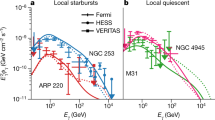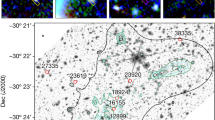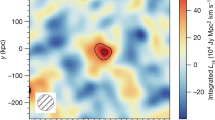Abstract
Kleinmann and Low1 and Low2 have recently reported measurements of the infrared spectrum of the Seyfert galaxy NGC 1068. The spectrum was found to be sharply peaked at a wavelength of ∼100 µm (with an uncertainty of a factor of two or three toward longer wavelengths), while the total infrared luminosity amounts to L∼2.5 × 1046 erg s−1 (for a Hubble constant H = 75 km s−1 Mpc−1). We wish to point out that, if NGC 1068 is not an anomalous object, the Seyfert galaxies alone may be important contributors to the infrared background in the submillimetre region, provided that cosmological evolutionary effects of the type discussed for radio sources and quasi-stellar sources are present3,4. (Low and Tucker5 have discussed the contribution to the far infrared background due to Seyferts and quasars, but it seems that the typical Seyfert that they considered emitted at a power level ten times smaller than NGC 1068, and that they assumed rather modest evolutionary effects. A rediscussion of this problem therefore seems worthwhile, especially in the light of recent measurements of the far infrared background.) We note that in this report we do not consider the nature of the “3K black body” radiation field observed at wavelengths well above 1 mm.
This is a preview of subscription content, access via your institution
Access options
Subscribe to this journal
Receive 51 print issues and online access
$199.00 per year
only $3.90 per issue
Buy this article
- Purchase on Springer Link
- Instant access to full article PDF
Prices may be subject to local taxes which are calculated during checkout
Similar content being viewed by others
References
Kleinmann, D. E., and Low, F. J., Astrophys. J. Lett., 159, L165 (1970).
Low, F. J., Astrophys. J. Lett., 159, L173 (1970).
Longair, M. S., Mon. Not. Roy. Astron. Soc., 133, 421 (1966).
Schmidt, M., Astrophys. J., 151, 393 (1968).
Low, F. J., and Tucker, W. H., Phys. Rev. Lett., 21, 1538 (1968).
McVittie, G. C., General Relativity and Cosmology (Univ. Illinois Press, 1965).
Shivanandan, K., Houck, J. R., and Harwit, M., Phys. Rev. Lett., 21, 1460 (1968).
Muehlner, D., and Weiss, R., Phys. Rev. Lett., 24, 742 (1970).
Bortolot, jun., V. J., Clauser, J. F., and Thaddeus, P., Phys. Rev. Lett., 22, 307 (1969).
Bridle, A. H., Mon. Not. Roy. Astron. Soc., 136, 219 (1967).
Minkowski, R., Astron. J., 73, 842 (1968).
Setti, G., and Rees, M. J., IAU Symp. No. 37 (edit. by Gratton, L.) (Reidel, 1969).
Author information
Authors and Affiliations
Rights and permissions
About this article
Cite this article
SETTI, G., WOLTJER, L. Infrared Background from Seyfert Galaxies. Nature 227, 586–587 (1970). https://doi.org/10.1038/227586a0
Received:
Issue Date:
DOI: https://doi.org/10.1038/227586a0
This article is cited by
-
The interrelationship between cosmic dust and the microwave background
Astrophysics and Space Science (1975)
-
Can the Sub-millimetre Background Radiation be Cosmological?
Nature (1971)
-
Infrared Background and Universal Cosmic Rays
Nature Physical Science (1971)
Comments
By submitting a comment you agree to abide by our Terms and Community Guidelines. If you find something abusive or that does not comply with our terms or guidelines please flag it as inappropriate.



